
The new Nissan Juke crossover has replaced the Micra in production at the company’s Sunderland, UK plant. Nick Holt tours the facility to find out more about the overall build processes, taking a closer look at individual changes made for the new model and how manufacturing plans for the Leaf EV are shaping up
When the Nissan plant in Sunderland, UK opened in 1986, the first car to enter production was the Bluebird saloon. Ten thousand were manufactured that year, recalls Andrew Drake, Production Manager in charge of the line now producing the Note compact car and new Juke crossover.
"When we opened, Nissan was already selling cars (in the UK), but they had gained a bad reputation for rusting," he says. "So the first order of business was to put that behind us and we ended up producing better quality here than in Japan. Now the bodywork is one of the best elements of the cars we build.” The press shop produces all large panels for the Note and Juke, as well as the Qashqai and Qashqai+2 models. Built in 1988, the facility features six presses: three of 2,700 tonnes, two of 3,200 tonnes and one 5,000 tonne press, by Hitachi Zosen. “Nissan has two 5,000 tonne presses in operation, the other is in our sister plant in Oppama (Japan). This one produces complete bodysides for all models manufactured here.” Drake says that only a 5,000 tonne press can reproduce the intricate panels, while handling the required part sizes.
“The bigger the panel, the bigger the die. The bigger the die, the bigger the press,” he points out. Whether the giant press is producing bodysides or simultaneously stamping two car doors, it can achieve rates of up to 16 punches per minute.
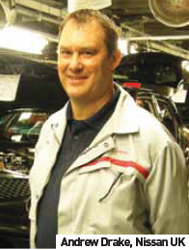 The 5,000 tonne transfer press rests on a foundation that reaches 200ft into the ground. As such, the press wasn’t so much installed in the building as the building was constructed around the press. “The press shop uses about 2,600 tonnes of steel per week, from which we make about 330,000 panels,” says Drake. “We operate over three shifts, with overtime added on Saturdays as necessary.” Contract suppliers such as Hashimoto deliver smaller pressed parts just-in-time to the plant.
The 5,000 tonne transfer press rests on a foundation that reaches 200ft into the ground. As such, the press wasn’t so much installed in the building as the building was constructed around the press. “The press shop uses about 2,600 tonnes of steel per week, from which we make about 330,000 panels,” says Drake. “We operate over three shifts, with overtime added on Saturdays as necessary.” Contract suppliers such as Hashimoto deliver smaller pressed parts just-in-time to the plant.
Other features of the press shop include the two Aisaku blanking presses, which cut parts directly from the steel coil. From there, panels are fed through a blank washer. “Oil on the steel sheets rarely affects operation within the transfer press, the washing process is not designed to remove this layer,” says Drake.
“Instead, we’re looking to remove as much dirt as possible; any particles on the blanks can affect die performance and the quality of the stamped parts.” The press shop has approximately 600 dies in storage, colour-coded by model and marked as to the part each produces.
They are regularly checked using the on-site test press to confirm individual die performance.
The 5,000 tonne transfer press line features five individual presses; all others at the plant have either two or three. Parts are removed manually at the smaller presses, but due to the size and weight of the parts produced by the larger installation, a series of robots work in unison to remove parts and load them into stillages. Each run delivers approximately 1,000 parts, of which 1% is checked for deformation and size.
The other robotic installation in the press shop is the laser welding facility. Drake: “We use this system to prepare tailored blanks before pressing, the joined blanks are primarily used to produce engine brace supports. The installation isn’t used to join two different metal types, but steels of different gauges.”
Nissan’s Sunderland plant has 10 wind turbines which produce about 8% of the facility’s total energy needs. While it’s a relatively small percentage of what the plant requires to maintain full production, the turbines still produce a considerable amount of ‘green’ energy.
Andrew Drake, Production Manager, Note and Juke: “The turbines are second-hand, we sourced them in Europe. The reason they’re here is to support the. This part of the facility represents about 55% of our total energy consumption and the ovens are on all the time. When we shut down, the turbines provide enough energy to keep the ovens running and if there’s any surplus, we can sell it back to the grid.

Moving from the press shop through to the bodyshop area, production of the three models is separated onto dedicated lines: Line 1 for Qashqai models and Line 2 for Note and Juke. Are Note and Juke grouped together because they’re based on the same platform? “It’s not identical,” says Andrew Drake, “but the Juke is very similar to the Note platform.”
Like most large production plants, the first step in the body-in-white process is to weld the front, centre and rear floor panel pressings into a single floorpan. “We carry out manual checks on the panels before they are joined,” says Drake. Although there are more than 780 robots throughout the work area, this same arrangement is repeated throughout the bodyshop, with 20% of all operations carried out by line staff. “In ‘grey’ areas, such as with panel inspection, we have manual stations. They’re usually at the start and finish of a process in order to check parts and final product quality.”
The centre section is the first to be loaded into the welding tray, which is used for both Note and Juke. While the front and rear sections are picked from fixed locations, the centre panel is picked from a tray, which while allowing parts for both models to be loaded, also means the robot must use lasers to locate the correct pickup points, based on the model being produced.
A large percentage of panels and parts used in the bodyshop are delivered by a network of AGVs, guided by magnetic strips and GPS units; vehicles and software were developed by an in-house team. “(In the bodyshop) sequential processes are not necessarily next to each other, so AGVs allow us to utilize every part of the area,” says Drake. “When a stillage is full of completed parts, sensors can call for an empty unit. When a supply stillage is nearly empty, the system can call for a resupply vehicle.” The largest robot in the bodyshop is used to lift the welded floorpans over the central corridor, keeping the area free for AGVs. “Parts are moved using forklifts and AGVs, but AGVs have the right of way,” he explains.
The next major step is to frame the Juke bodyshell, but to help improve dimensional accuracy the floor and bodyside are married using a crimped join. On each car there are three crimping tags, the material engineered into the panels and specifically cut for the purpose in the blanking press. These tabs are folded over automatically, fixing the bodysides and floorpan before each body enters the framing station for alignment and final welds. As it takes three times longer to produce a bodyside than a floorpan, three separate welding stations are used to produce these sections in order to keep pace with production. Welding in the framing station is completed by 15 robots, which like most in the bodyshop are self-maintaining. “We use about 12,000 amps to create a weld, a process which slowly burns the weld tip,” says Drake. “Every four or five bodies, the robot presents its weld tip to a laser and if there’s no reflection it’s sharpened, meaning the burn is removed.
This also checks the ‘throw’ of the tip, which if worn down, must be replaced. This is done automatically within the cell, we only have to resupply the tips.” This changeover process also cuts the cooling system that delivers chilled water to within 15mm of the welding tip to help cool the area and improve durability. Drake says that he has used a laser thermometer to measure the temperature of the tip directly after a weld and it registered only 20oC.
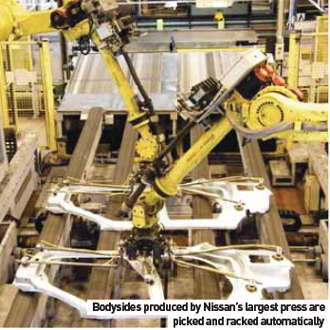 He further explains that it takes about eight hours to train each robot, though most of this is to design the choreography so they don’t collide with each other within the cell. To add or remove a single weld takes about 20 minutes using a hand-held command module. Preventative maintenance is performed based on information delivered from heat-sensitive pads within each robot. Should a unit overheat, a team can fix the robot before it fails – while repeated overheating indicates a durability problem. This requires that a specific task or sequence be run on a test robot, the motion repeated indefinitely to both understand the problem and devise a solution.
He further explains that it takes about eight hours to train each robot, though most of this is to design the choreography so they don’t collide with each other within the cell. To add or remove a single weld takes about 20 minutes using a hand-held command module. Preventative maintenance is performed based on information delivered from heat-sensitive pads within each robot. Should a unit overheat, a team can fix the robot before it fails – while repeated overheating indicates a durability problem. This requires that a specific task or sequence be run on a test robot, the motion repeated indefinitely to both understand the problem and devise a solution.
While a small number of joins are made using rivets and other techniques, spot welds are the primary joining solution. In total, there are about 3,000 welds on a Juke body, which compares to 2,700 on Note and 3,500 on Qashqai.
Approximately every 60 cars, a body is removed from the line to test weld integrity. Drake says that there are two tests: the ‘chisel’ check, a non-invasive, non-destructive test designed to check weld strength, while welds in more remote areas of the body are tested using ultrasonic equipment. Each selected vehicle is tested in a different area, the engine bay, interior, etc., and then returned to the line, meaning that over the course of a shift, all welds across the vehicle are tested for strength and integrity.
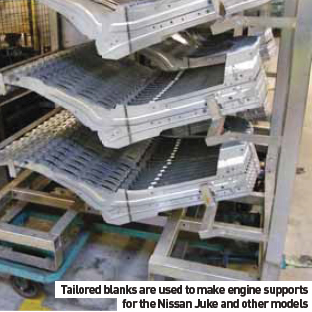 Drake: “If a weld is found to be missing, a maintenance team member and the test technician return to the robot in question to fix the problem. Then they follow production through to final assembly to find the first vehicle with a good weld and those vehicles missing the weld are directed to the rework area.”
Drake: “If a weld is found to be missing, a maintenance team member and the test technician return to the robot in question to fix the problem. Then they follow production through to final assembly to find the first vehicle with a good weld and those vehicles missing the weld are directed to the rework area.”
Various welding robots in the bodyshop are not limited to performing single processes. “In some areas, we have machines that can complete three different jobs,” explains Drake. Robotic head changes are the key to this flexibility; some machines using in turn a welding head, a sealing head and a picking head to complete a single process routine.
For panels that cannot be welded, including the bonnet, doors and tailgate, hemming is the joining method of choice. This is a fully-automated process that first brings together the outer panel, a reinforcing inner panel and the required adhesive product. The second step sees this assembly moved to a tabletop hemming system where the part’s four sides are simultaneously folded over to make the join.
In preparation for paint, the hemmed doors are set on the individual car bodies using a magnetic tool that fixes gap and flush. Laser ID tags are also removed before the body is transferred to a paintshop hangar to complete the 11-stage cleaning and paint process.
Nissan’s first electric vehicle was developed in 1947. The Leaf is the carmaker’s latest electric vehicle, which having already entered production at Oppama, Japan, will also be produced in Smyrna, Tennessee (2012) and at the Sunderland, UK plant in 2013.
In planning for the Leaf build, have any processes required the setup of dedicated stations for EV production? “We haven’t found one,” says Andrew Drake, Production Manager for the Note and Juke – and Leaf. “Instead of building an engine, we’ll be building an electric motor, an inverter pack. There might be some sub-assembly stations, but it’s just the difference between petrol and diesel versions.”
Drake says that the car has been developed to make best use of what is already available in existing global Nissan plants. “In the same way that we build an engine, we build an electric motor. The motor and transmission for the Leaf will be assembled in much the same way as an engine in preparation for delivery to the production line.” He continues by saying that a lifter will be used to install the drivetrain. “The same system will be used to install the 750kg battery pack. It’s essentially a battery marriage station.”
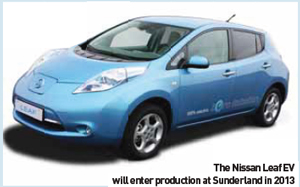 A new lithium-ion battery manufacturing facility is already under construction at Sunderland, with start-of-production scheduled for Q3 2011. “We’ll be making batteries here before we start building Leaf,” says Drake. “We’ll start by supplying batteries into the Renault-Nissan network and when we start vehicle production, the batteries will simply come from there to here.”
A new lithium-ion battery manufacturing facility is already under construction at Sunderland, with start-of-production scheduled for Q3 2011. “We’ll be making batteries here before we start building Leaf,” says Drake. “We’ll start by supplying batteries into the Renault-Nissan network and when we start vehicle production, the batteries will simply come from there to here.”
Line staff dealing with Leaf models will need trained in the correct procedures for handling HV (high voltage) parts. Drake: “We’ve got people travelling to Japan for this training. Everyone in the shop will be certified to different levels, according to what they’ll do on the line.”
Another building under construction at Nissan Sunderland is the new training centre, where emergency services will learn how to deal with electric vehicles in situations including road incidents and fires. Following the successful completion of final electrical checks, one of the last steps of the Leaf build is to connect the master switch; the same switch that crews will use to disconnect the batteries and drivetrain.
“In the event of an accident, you flip up the centre console and pull the handle. It’s the last thing we connect and the first thing that should be disconnected.”
There are seven kilometres of track in the paintshop at Nissan Sunderland, which pass each Juke body through a series of six ovens. On the Qashqai line, three-shift production required an extension to the ovens. “The Qashqai ovens have been extended to support 50 units,” says Andrew Drake. “The ovens used for Juke and Note can hold 35 units, but if we go to three shifts for those models, we’ll have to do the same for these.”
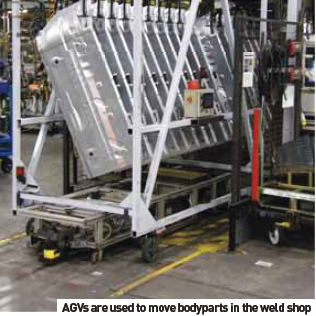 Like all other vehicles produced at Sunderland, Juke bodies entering the paint process are first dipped in a tank of zinc phosphate, the principal cleaning agent. The bodies are then rinsed and flashed off at 120C for 40 minutes. The next step is to run the bodies through an anti-corrosive electrocoat dip. Drake says the mixture is made up of seven parts resin and one part water-based grey paint. “The bodies stay in the tank for two minutes. A positive charge is applied to the body and a negative charge to the tank of between 230 and 250V DC, which results in an electrolytic deposit on the car body. As the coat gets thicker it creates a higher resistance, meaning that if it stayed in there for an hour, the thickness of the coating would not be more than the required three microns.” A de-ionized water shower is used to remove excess material, which is collected for recycling.
Like all other vehicles produced at Sunderland, Juke bodies entering the paint process are first dipped in a tank of zinc phosphate, the principal cleaning agent. The bodies are then rinsed and flashed off at 120C for 40 minutes. The next step is to run the bodies through an anti-corrosive electrocoat dip. Drake says the mixture is made up of seven parts resin and one part water-based grey paint. “The bodies stay in the tank for two minutes. A positive charge is applied to the body and a negative charge to the tank of between 230 and 250V DC, which results in an electrolytic deposit on the car body. As the coat gets thicker it creates a higher resistance, meaning that if it stayed in there for an hour, the thickness of the coating would not be more than the required three microns.” A de-ionized water shower is used to remove excess material, which is collected for recycling.
Once the undercoat is complete, sealant is manually applied to the car bodies in order to ensure quality.
A rubberized stone guard coating is also added to the underside of the sill and the rear wheel arch – the front of the vehicle receives its own plasticoat protectant after painting. These products are then cured in a further oven.
Nissan uses three primer colours, white, light gray or dark gray, depending on the final topcoat colour. With regards to topcoat, suppliers are based permanently on site, both to check new deliveries for colour and also viscosity, an important characteristic as the paint is not applied using air but forced through under pressure.
A body storage area, located above final assembly, holds a small number of painted car bodies. “The buffer holds about 50 cars,” says Andrew Drake. “A computer system delivers cars to the line in the best possible mix of high- and lowspecification models, which allows us to balance the line.”
The first operation is to remove doors for kitting, a process that has recently undergone a dramatic overhaul.
“We previously used a standard racking system for delivery of door parts, but we needed a new method to handle increasing part complexity,” says Drake. “The new system is one of our Kaizens, where pre-selected parts for individual doors are boxed for delivery to the line by AGVs. The boxes travel down the line together with the doors and parts are picked from the boxes.” Upon completion, the doors are delivered to one of two holding areas, either Note or Juke, to wait for the corresponding vehicle to finish its three-hour journey around the assembly line.
He further explains that Nissan Sunderland has used a series of Kaizens that feature low-cost automation to improve process efficiency across the plant. "This (door kitting) system has considerably reduced lineside density.
This was one of the ideas developed in our dedicated shop, staffed by people from the line, and we installed the solution ourselves. We can do this at a lower cost than having an engineering company do it.” The solution has removed the need for lineside racking and part delivery, but despite this, Drake says that if they were to redo the plant, the assembly area could benefit from some additional width.
On the line, Drake says one of the changes required in switching from Micra to Juke was adjusting the conveyor dollies. “We’re using the same dollies for these models. We just had to modify the four steels the car sits on, the inner set is for Note, outer for Juke.” This was made easier owing to the similarity between Juke and Note chassis? “The chassis is similar, but we use different pick up points to get the balance right for the car.” He goes on to say that when the Leaf enters production, a third set of supports will be added to the same dollies.
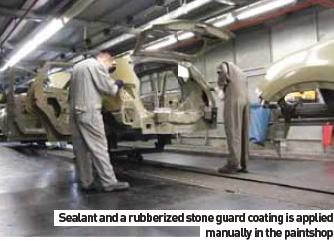 As for tooling, Andrew Drake says that five years ago, 100% of tools on the assembly line used compressed air, but now these tools are only used to complete general fastenings. “The biggest problems with compressed air is the hoses. Workers can trip over them and they can scratch the cars.” He says that a lot of air-powered tooling has been replaced with ‘high-capability’ tools. Powered via a DC current, these record all achieved torques, particularly useful in safety-critical processes such as fastening brake pedals.
As for tooling, Andrew Drake says that five years ago, 100% of tools on the assembly line used compressed air, but now these tools are only used to complete general fastenings. “The biggest problems with compressed air is the hoses. Workers can trip over them and they can scratch the cars.” He says that a lot of air-powered tooling has been replaced with ‘high-capability’ tools. Powered via a DC current, these record all achieved torques, particularly useful in safety-critical processes such as fastening brake pedals.
This has also resulted in a reduction in the need to generate compressed air. “We used to have four compressors, but now run only two.”
The assembly line is split into zones, each of which has a dedicated supervisor monitoring the performance of approximately 20 line workers. Every 20 stations, cars travelling along the assembly line must be handed over to the next zone, defect-free, via a quality gate. If there are any problems, inspectors may use the Andon system for on-line fixes.
“Repairs tend to be required when an operator has missed something based on specification, left- and right-hand drive, etc. We produce about 112 variants of the car, depending on its destination, so it’s mostly down to spec. If it can’t be repaired on the line – for example, if the bodyshop has missed a bracket – it’ll be noted and fixed in the rework area.”
How does the inspector manage to complete checks on all the parts within the takt? “We have what is called a ‘quality map’. These are the key things that the inspector must check. Depending on the faults they locate, if an item on the list is never missed, then we remove it from the map. This way, the inspector can concentrate on known problems.” Drake adds that when a new model enters production, more inspectors are added to carry out additional checks. It’s a case of looking for the path of most – not least – resistance. “It’s very pro-active, very dynamic” he says. “We’re all linked by PC, so I’m always in touch with what’s happening on the line.”


































